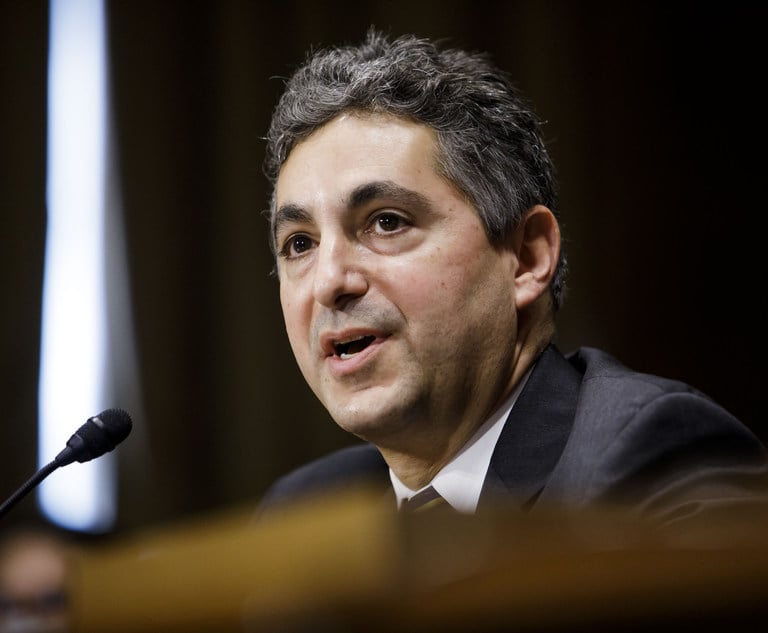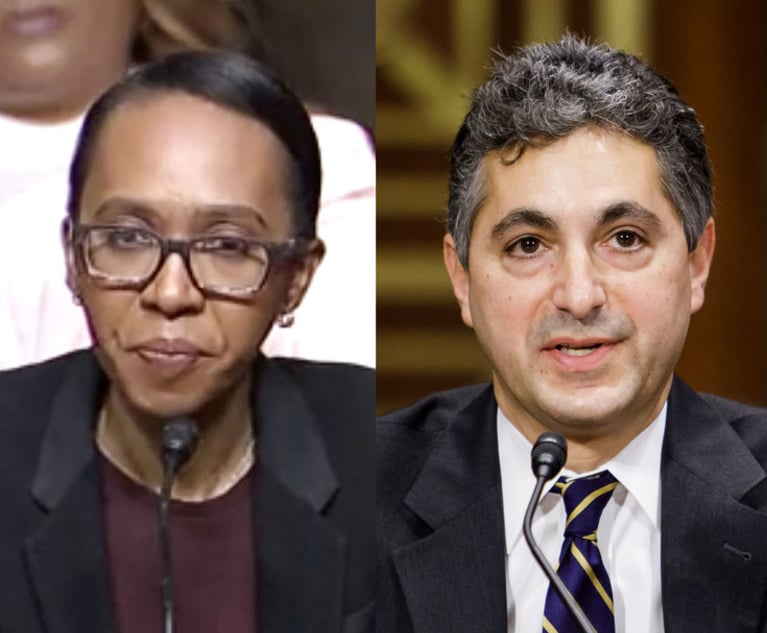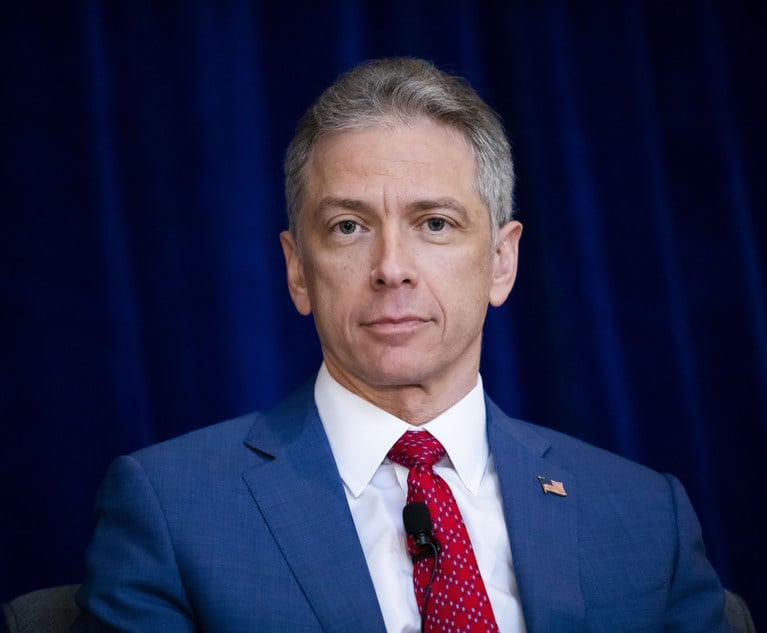Skilled in the Art: Supreme Court Spotlight Shifts to Trademark Remedies + NPE Suits Up, PTAB Filings Down + Who's Arguing—$2.5 Billion Edition
The Supreme Court is set to decide the statutory prerequisites for awarding infringer's profits under the Lanham Act.
July 03, 2019 at 10:52 AM
9 minute read
Welcome to Skilled in the Art. I'm Law.com IP reporter Scott Graham. We've got one more IP case to throw on the Supreme Court's griddle. The justices are going to decide the statutory prerequisites for awarding infringer's profits under the Lanham Act. I have some context below from a Debevoise & Plimpton partner. Meanwhile, Unified Patents reports that PTAB filings, which have been steady-eddy over the last five years, are suddenly on pace to drop by 24% this year. I've talked with a couple of practitioners who have theories, including a former (acting) chief judge of the PTAB. If you have your own theories, don't be shy: email me here, and follow me on Twitter.
 Williams & Connolly partner Lisa Blatt. Photo: Diego Radzinschi/ALM.
Williams & Connolly partner Lisa Blatt. Photo: Diego Radzinschi/ALM.
No Amici, No Problem for Trademark Case
When Romag Fasteners asked the Supreme Court to resolve a circuit split over infringer's profits in trademark cases, opponents Fossil and Macy's argued that a ruling either way won't have much impact.
“The absence of amicus support for the petition—even though associations representing trademark owners regularly file briefs addressing questions they deem important—confirms the lack of meaningful conflict and the unimportance of the issue presented,” Gibney, Anthony & Flaherty partner Jeff Dupler argued in opposition.
That didn't stop the Supreme Court from granting cert Friday in Romag Fasteners v. Fossil. My knee-jerk reaction: Once again, the Supreme Court has taken up an IP issue that nobody cares about.
Not so, says David Bernstein, chair of Debevoise & Plimpton's IP litigation group, who predicts the amicus briefs will soon be rolling in.
“I actually think this is a critically important case,” said Bernstein, who recently co-authored an amicus for the International Trademark Association in a different Supreme Court case. “It's probably the most important unresolved issue there is in trademark remedies law.”
Romag sells magnetic snap fasteners used in wallets, handbags and other leather goods. It sued apparel maker Fossil, Macy's and other retailers for infringement. U.S. District Judge Janet Bond Arterton declined to award infringer's profits because the jury did not find willful infringement and the Federal Circuit, applying Second Circuit law, affirmed.
The issue is whether a finding of willful infringement is a prerequisite to awarding infringer's profits in a trademark action. Six circuits say it is, while six others say the infringer's intent is merely one factor among many a court should take into account in fashioning an equitable remedy. I'm not even going to attempt to summarize the provision of the Lanham Act that's at issue, Section 1117(a). As Dennis Crouch pointed out, it's pretty much a hash.
The short version is that plaintiffs “shall be entitled” to defendant's profits, including for willful infringement, “subject to the principles of equity.”
“Because a plaintiff's actual damages are often difficult to measure, an award of an infringer's profits is often the only meaningful monetary relief that trademark owners can secure for infringement,” Williams & Connolly partner Lisa Blatt argued in her cert petition for Romag. (It's one of three cases Blatt is set to argue to the Supreme Court next year, my ALM colleague Marcia Coyle pointed out.)
Debevoise's Bernstein said there will be a lot interest in the case. Trademark plaintiffs have become more aggressive in recent years in claiming infringer's profits, to the point it's “almost being weaponized,” he said.
If plaintiffs can show they lost sales due solely to consumer confusion, then they ought to be able to recover infringer's profits, he said. But the reality is that confusion is usually only one part of the equation. “Some people are buying the handbag because it's a good handbag. They don't care who makes the fastener,” he said.
In such cases, disgorgement of all profits may be overkill, Bernstein said. That's especially true in the context of the Lanham Act, which he said is designed “not to be punitive, but compensatory.”
 Source: Unified Patents
Source: Unified Patents
NPE Suits Up, PTAB Filings Down
The first half of 2019 is in the books and Unified Patents has already crunched the numbers for patent litigation. Long story short: NPE litigation is on the comeback in district courts, while PTAB filings are substantially down for the first time in years.
Some 660 AIA petitions were filed at the PTAB in the first half of the year. That puts petitions on pace for 1,320 this year, which would be a 24% drop from the 1,748 average for the last five years. (Filings had been remarkably steady up till now, numbering 1,702, 1,793, 1,732, 1,796 and 1,717 over the previous five years.)
Nate Kelley, the former PTO solicitor and acting PTAB chief judge who's now a partner at Perkins Coie, said that new rules governing institution decisions may be coming into play. He notes the board is increasingly willing to invoke its Section 325(d) discretion to deny multiple petitions raising the same prior art or arguments (even from different petitioners). “There is a perception that we are inching towards a one-and-done regime,” Kelley said. “The fact that a first petition was denied can be the very reason why a second petition will be denied. As a result, there is probably a lot more care going into each and every petition.”
Former PTAB Judge Scott Kamholz, who now practices at Covington & Burling, said the declining institution rate in general could be discouraging petitioners. PTAB decisions not to institute don't stop accused infringers from putting on the same invalidity defense in district court. But in general, “district judges don't like it if you come into court with something that couldn't pass muster at the institution stage,” Kamholz says.
Kamholz thinks a lot of other factors could be in play too. A strong economy could have business leaders more focused on building their companies rather than fighting over patents; the Supreme Court's SAS Institute decision has arguably put more teeth into the estoppel rules; and, paradoxically, the PTAB's own success at cooling off district court litigation might be catching up with it. “Dampening demand for patent litigation dampens the need for PTAB proceedings,” he said.
We'll know by this time next year if that last theory holds true, now that NPE filings are back on the upswing in district courts.
Unified counts 1,730 new district court filings overall during the first half, including almost 900 in Q2, which it says is the most in a single quarter since 2017. That number was fueled in part by 550 NPE suits, which Unified says is the most in a single quarter since 2016.
Unified, whose mission is to deter abusive NPE activity, is doing its part to keep the PTAB busy. It filed 28 petitions during the first half, tied with Google for second most, behind only Apple.

Who's Arguing – $2.5 Billion Edition
Merck & Co. won a $200 million jury verdict for patent infringement against Gilead Sciences in 2016 over its lifesaving hepatitis C drug, only to see U.S. District Judge Beth Labson Freeman rip it away because of Merck's unclean hands. The Federal Circuit affirmed last year following a marathon oral argument.
But that was just chicken feed compared to the whopping $2.5 billion verdict Merck subsidiary Idenix won in Delaware federal court in 2016—only to see U.S. District Judge Leonard Stark knock out that one too. Stark ruled that no reasonable juror could have found Idenix had enabled a person of skill in the art to identify the molecule that Gilead would call sofosbuvir.
That jury award, which Gilead calls the largest in patent history, will hang in the balance Monday as Merck and Gilead square off once again at the Federal Circuit. Jones Day partner Greg Castanias is set to argue that Stark overstepped, and that jurors rightfully awarded Merck a sliver of Gilead's $25 billion in infringing sofosbuvir sales. Orrick, Herrington & Sutcliffe partner Josh Rosenkranz will argue for Gilead that it's time to bring Merck's “worldwide litigation war” to an end.
Sofosbuvir was developed by Pharmasset, which Gilead acquired in 2011. Idenix sued in 2013, alleging that Pharmasset stole its idea of using two-prime (2')-methyl up modified nucleosides to treat HCV. The company said Pharmasset chemist Jeremy Clark used Idenix's patent application as a guide to develop his breakthrough 2'-methyl up 2'-fluoro down compound that became sofosbuvir. Merck acquired Idenix in 2014.
Stark ruled that Idenix's patent identified potentially billions of compounds, and that further experimentation was “indispensable and exploratory—rather than confirmatory” in order to synthesize sofosbuvir.
Castanias argues in Merck's brief that trial evidence showed Clark was literally holding Idenix's patent application in his hand when he proposed working on the compound that became sofosbuvir. “Gilead had to prove, by clear-and-convincing evidence, that the claims were not enabled,” Castanias writes. “And to prevail on JMOL, Gilead had to show that no rational juror could have found Gilead failed to meet that high burden. Gilead did not come close.”
Rosenkranz argues for Gilead that the Patent Trial and Appeal Board has already found Idenix's patents not enabled, a decision the Federal Circuit ruled was supported by substantial evidence.
“Idenix was not entitled to block an entire field of study with a mere plan to investigate billions of compounds, however insightful it was as basic research,” Rosenkranz writes. “Idenix certainly did not deserve the largest patent verdict in history for a patent claiming a compound it did not describe and could not make.”
That's all from Skilled in the Art this week. I'll be celebrating Independence Day (Thursday and) Friday, so I'll see you all again next Tuesday.
This content has been archived. It is available through our partners, LexisNexis® and Bloomberg Law.
To view this content, please continue to their sites.
Not a Lexis Subscriber?
Subscribe Now
Not a Bloomberg Law Subscriber?
Subscribe Now
NOT FOR REPRINT
© 2025 ALM Global, LLC, All Rights Reserved. Request academic re-use from www.copyright.com. All other uses, submit a request to [email protected]. For more information visit Asset & Logo Licensing.
You Might Like
View All
Skilled in the Art With Scott Graham: I'm So Glad We Had This Time Together

Design Patent Appeal Splinters Federal Circuit Panel + Susman Scores $163M Jury Verdict + Finnegan Protects Under Armour's House
Trending Stories
- 1Public Notices/Calendars
- 2Wednesday Newspaper
- 3Decision of the Day: Qui Tam Relators Do Not Plausibly Claim Firm Avoided Tax Obligations Through Visa Applications, Circuit Finds
- 4Judicial Ethics Opinion 24-116
- 5Big Law Firms Sheppard Mullin, Morgan Lewis and Baker Botts Add Partners in Houston
Who Got The Work
J. Brugh Lower of Gibbons has entered an appearance for industrial equipment supplier Devco Corporation in a pending trademark infringement lawsuit. The suit, accusing the defendant of selling knock-off Graco products, was filed Dec. 18 in New Jersey District Court by Rivkin Radler on behalf of Graco Inc. and Graco Minnesota. The case, assigned to U.S. District Judge Zahid N. Quraishi, is 3:24-cv-11294, Graco Inc. et al v. Devco Corporation.
Who Got The Work
Rebecca Maller-Stein and Kent A. Yalowitz of Arnold & Porter Kaye Scholer have entered their appearances for Hanaco Venture Capital and its executives, Lior Prosor and David Frankel, in a pending securities lawsuit. The action, filed on Dec. 24 in New York Southern District Court by Zell, Aron & Co. on behalf of Goldeneye Advisors, accuses the defendants of negligently and fraudulently managing the plaintiff's $1 million investment. The case, assigned to U.S. District Judge Vernon S. Broderick, is 1:24-cv-09918, Goldeneye Advisors, LLC v. Hanaco Venture Capital, Ltd. et al.
Who Got The Work
Attorneys from A&O Shearman has stepped in as defense counsel for Toronto-Dominion Bank and other defendants in a pending securities class action. The suit, filed Dec. 11 in New York Southern District Court by Bleichmar Fonti & Auld, accuses the defendants of concealing the bank's 'pervasive' deficiencies in regards to its compliance with the Bank Secrecy Act and the quality of its anti-money laundering controls. The case, assigned to U.S. District Judge Arun Subramanian, is 1:24-cv-09445, Gonzalez v. The Toronto-Dominion Bank et al.
Who Got The Work
Crown Castle International, a Pennsylvania company providing shared communications infrastructure, has turned to Luke D. Wolf of Gordon Rees Scully Mansukhani to fend off a pending breach-of-contract lawsuit. The court action, filed Nov. 25 in Michigan Eastern District Court by Hooper Hathaway PC on behalf of The Town Residences LLC, accuses Crown Castle of failing to transfer approximately $30,000 in utility payments from T-Mobile in breach of a roof-top lease and assignment agreement. The case, assigned to U.S. District Judge Susan K. Declercq, is 2:24-cv-13131, The Town Residences LLC v. T-Mobile US, Inc. et al.
Who Got The Work
Wilfred P. Coronato and Daniel M. Schwartz of McCarter & English have stepped in as defense counsel to Electrolux Home Products Inc. in a pending product liability lawsuit. The court action, filed Nov. 26 in New York Eastern District Court by Poulos Lopiccolo PC and Nagel Rice LLP on behalf of David Stern, alleges that the defendant's refrigerators’ drawers and shelving repeatedly break and fall apart within months after purchase. The case, assigned to U.S. District Judge Joan M. Azrack, is 2:24-cv-08204, Stern v. Electrolux Home Products, Inc.
Featured Firms
Law Offices of Gary Martin Hays & Associates, P.C.
(470) 294-1674
Law Offices of Mark E. Salomone
(857) 444-6468
Smith & Hassler
(713) 739-1250










